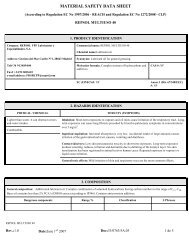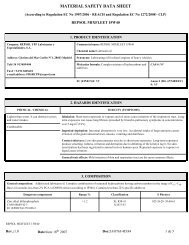REPSOL TURBOARIES 32
REPSOL TURBOARIES 32
REPSOL TURBOARIES 32
Create successful ePaper yourself
Turn your PDF publications into a flip-book with our unique Google optimized e-Paper software.
11. TOXICOLOGICAL INFORMATION<br />
Routes of exposure: Contact with skin, eyes and inhalation. Ingestion is not frequent.<br />
Acute and chronic effects: No malignant acute effects are known. Irritation by contact with liquid and prolonged inhalation of vapours or oil mists<br />
are the most common effects.<br />
LD 50 >15 g/Kg (oral-rat)<br />
LD 50 >5 g/Kg (skin-rat)<br />
Carcinogenicity: Base oil: IARC classification: Group 3 (The agent is not classifiable as to its carcinogenicity to humans)<br />
Reproductive toxicity: No evidences.<br />
Medical conditions which increase hazard to exposure: Respiratory tract deficiencies and dermatological problems.<br />
12. ECOLOGICAL INFORMATION<br />
Pollutant potential:<br />
Persistence and degradability:The material is oily and viscous and floats on water. It presents a high physical fouling potential, mainly in seaspills;<br />
by contact destroys small aquatic organisms and makes living difficult for upper organisms, not allowing the sunlight to reach underlying<br />
marine ecosystems, affecting its normal development. It is not readily biodegradable.<br />
Mobility/bioaccumulative potential:There are no data to indicate that the product is significantly bioaccumulated by aquatic organisms or<br />
incidence in the trophic food chain, although it may cause long-term adverse effects in the aquatic environment, due to its high physical fouling<br />
potential.<br />
Ecotoxicological effects: : LL 50 (Lethal loading)>1,000 mg/l (lubricant base oils). Dangerous for aquatic life in high concentrations (spillages).<br />
13. DISPOSAL CONSIDERATIONS<br />
Disposal methods (surplus): Recycling and recovery of base oils when possible.<br />
Waste: Liquids and solids from industrial process; do not attempt to clean containers since residue is difficult to remove; dispose in a safe way.<br />
Disposal: Only in specific prepared and controlled areas. Avoid releasing waste oils to sewers because they can destroy water treatment plant<br />
microorganisms.<br />
Handling: Labelled and sealed containers. Avoid direct contact with waste oils.<br />
Provisions: Companies which recover, dispose, store, transport or handle waste should comply with Dir. 2008/98/EC on waste, or other local,<br />
national or community provisions.<br />
<strong>REPSOL</strong> <strong>TURBOARIES</strong> <strong>32</strong><br />
Rev.:1.1 Date:April 25 th 2011 Doc:33/0763/5G.10 4 de 5
















